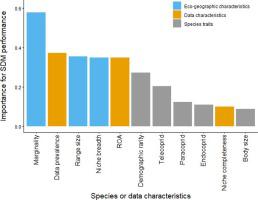Ecological Indicators ( IF 6.9 ) Pub Date : 2020-11-20 , DOI: 10.1016/j.ecolind.2020.107147 Geiziane Tessarolo , Jorge M. Lobo , Thiago Fernando Rangel , Joaquín Hortal

|
Species distribution models (SDM) are widely used as indicators of different aspects of geographical ranges for many purposes, from conservation to biogeographical and evolutionary analyses. However, these techniques are susceptible to various sources of uncertainty. Data coverage, species’ ecology, and the characteristics of their geographic distributions can affect SDM results, often generating critical errors in predicted distribution maps. We assess the influence of data quality, the characteristics of species distributions, and ecological traits on SDM performance. We predict the distributions of dung beetle species in Madrid region (central Spain) using six SDM techniques and validate them on an independent dataset. We relate variations in model performance with environmental completeness, data characteristics, and species traits through a partial least squares analysis. In this analysis, body size, nesting behaviour, marginality, rarity, data prevalence, Relative Occurrence Area (ROA), range size, niche breadth, and completeness are used as predictors of six assessment metrics (sensitivity, specificity, kappa, TSS, CCR, and AUC). Marginality and data prevalence were the variables that most influenced SDM performance, followed by range size, ROA, and niche breadth: species presenting higher marginality and data prevalence, and smaller ROA and niche breadth were associated with better models. Nesting behaviour, rarity, niche completeness, and body size had minor importance for SDM performance. Our results highlight the importance of taking species’ and data characteristics into account when modelling and comparing large groups of species using SDM. This implies that estimates of species richness and composition based on stacked SDMs can show high levels of error if they are constructed for groups of species with diverse ecological traits and types of geographic distributions. We suggest that the species holding characteristics that lead to poor SDM performance should not be included when constructing composite biodiversity variables. Further effort is needed to develop SDM methodologies and protocols that account for such source of uncertainty.
中文翻译:

数据特征对物种分布模型性能的影响存在高度不确定性
物种分布模型(SDM)被广泛用作从保护到生物地理和进化分析等许多方面的地理范围不同方面的指标。但是,这些技术易受各种不确定性因素的影响。数据覆盖范围,物种生态及其地理分布特征会影响SDM结果,通常会在预测的分布图中产生严重错误。我们评估数据质量,物种分布特征和生态特征对SDM性能的影响。我们使用六种SDM技术预测马德里地区(西班牙中部)的甲虫物种分布,并在独立的数据集上对其进行验证。我们将模型性能的变化与环境完整性,数据特征,通过部分最小二乘分析得出物种和物种特征。在此分析中,将身体大小,筑巢行为,边缘性,稀有性,数据普遍性,相对发生区域(ROA),相对大小,小生境广度和完整性用作六个评估指标(敏感性,特异性,κ,TSS,CCR)的预测指标和AUC)。边际性和数据普遍性是影响SDM性能的变量,其次是范围大小,ROA和利基宽度:具有较高边际性和数据普遍性的物种以及ROA和利基宽度较小的物种与较好的模型相关。嵌套行为,稀有性,小生境完整性和体型对SDM性能影响不大。我们的结果强调了在使用SDM对大型物种进行建模和比较时,考虑物种和数据特征的重要性。这意味着,如果为具有不同生态特征和地理分布类型的物种群体构建基于堆积的SDM的物种丰富度和组成估计,则会显示出很高的误差水平。我们建议在构建复合生物多样性变量时,不应包括导致SDM性能下降的物种特征。需要进一步的努力来开发解决这种不确定性来源的SDM方法和协议。我们建议在构建复合生物多样性变量时,不应包括导致SDM性能下降的物种特征。需要进一步的努力来开发解决这种不确定性来源的SDM方法和协议。我们建议在构建复合生物多样性变量时,不应包括导致SDM性能下降的物种特征。需要进一步的努力来开发解决这种不确定性来源的SDM方法和协议。


























 京公网安备 11010802027423号
京公网安备 11010802027423号